Employee and Labour Relations in Canada: Laws and Unionization Impact
VerifiedAdded on 2023/01/13
|7
|1384
|75
Essay
AI Summary
This essay provides a comprehensive overview of employee and labour relations in Canada. It begins by outlining key legislation, including the Labour Relations Act, Employment Standards Legislation, Human Rights Legislation, Occupational Health and Safety Legislation, and Worker's Compensation legislation, explaining their roles in protecting employee rights and regulating workplace practices. The essay then delves into the characteristics of the unionized workforce in Canada, discussing the structure and function of unions. Furthermore, it highlights the benefits of unionization for workers, such as improved wages, better working conditions, and enhanced job security. The essay concludes by emphasizing the importance of unionization in fostering a stable and productive economic environment in Canada. The essay is well-supported by referencing academic books and journals, providing a strong foundation for its analysis.

EMPLOYEE AND
LABOUR
RELATIONS
LABOUR
RELATIONS
Paraphrase This Document
Need a fresh take? Get an instant paraphrase of this document with our AI Paraphraser
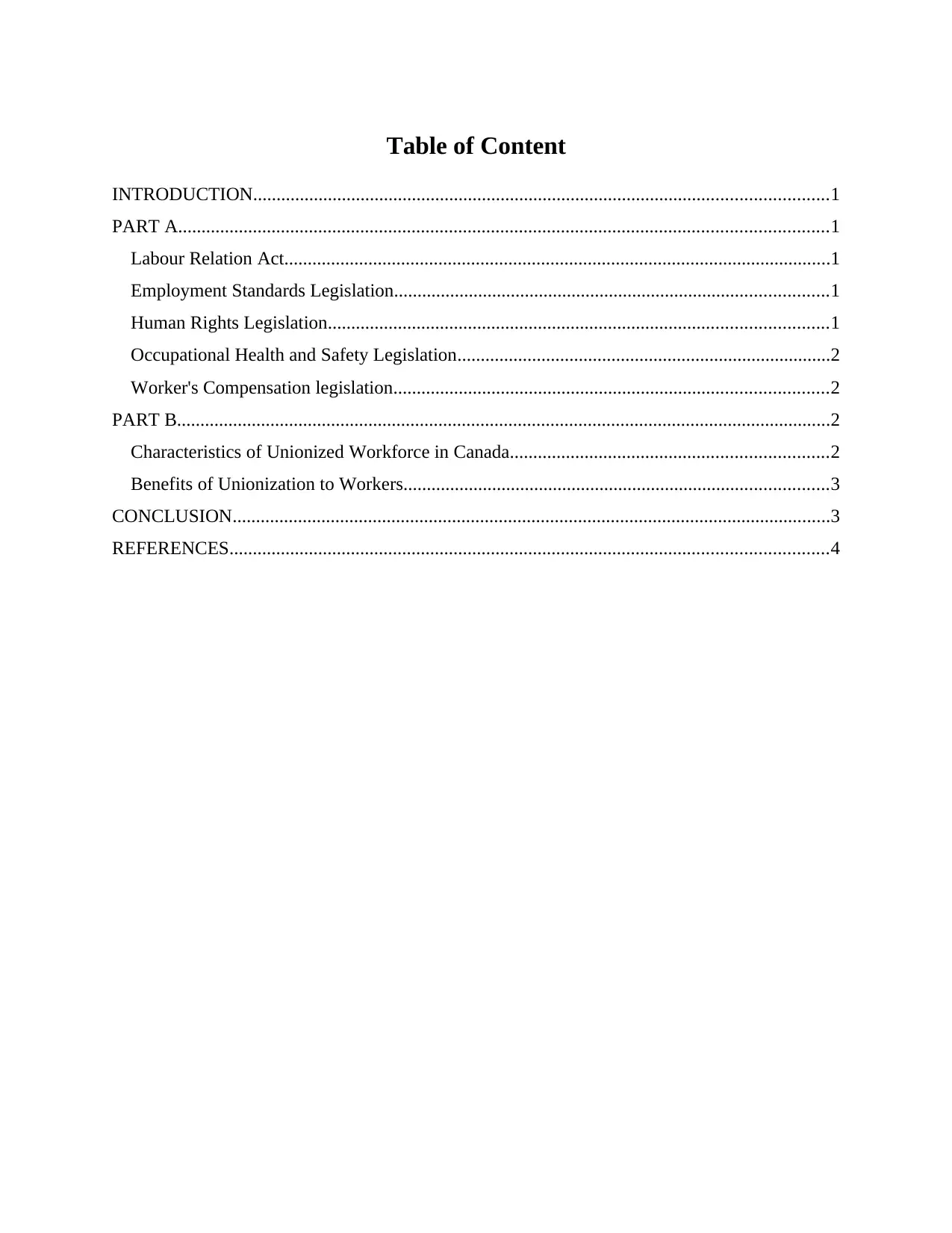
Table of Content
INTRODUCTION...........................................................................................................................1
PART A...........................................................................................................................................1
Labour Relation Act.....................................................................................................................1
Employment Standards Legislation.............................................................................................1
Human Rights Legislation...........................................................................................................1
Occupational Health and Safety Legislation................................................................................2
Worker's Compensation legislation.............................................................................................2
PART B............................................................................................................................................2
Characteristics of Unionized Workforce in Canada....................................................................2
Benefits of Unionization to Workers...........................................................................................3
CONCLUSION................................................................................................................................3
REFERENCES................................................................................................................................4
INTRODUCTION...........................................................................................................................1
PART A...........................................................................................................................................1
Labour Relation Act.....................................................................................................................1
Employment Standards Legislation.............................................................................................1
Human Rights Legislation...........................................................................................................1
Occupational Health and Safety Legislation................................................................................2
Worker's Compensation legislation.............................................................................................2
PART B............................................................................................................................................2
Characteristics of Unionized Workforce in Canada....................................................................2
Benefits of Unionization to Workers...........................................................................................3
CONCLUSION................................................................................................................................3
REFERENCES................................................................................................................................4
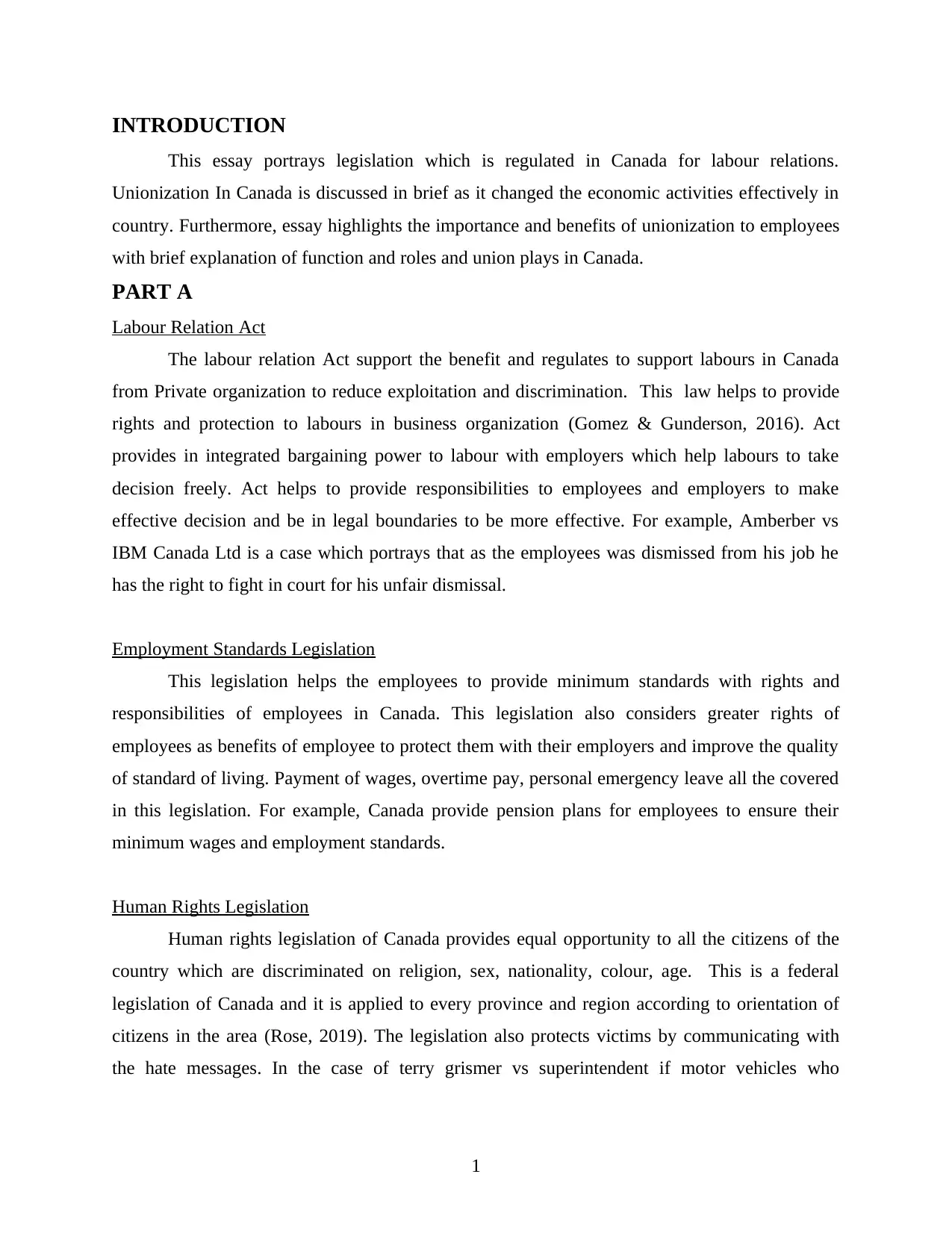
INTRODUCTION
This essay portrays legislation which is regulated in Canada for labour relations.
Unionization In Canada is discussed in brief as it changed the economic activities effectively in
country. Furthermore, essay highlights the importance and benefits of unionization to employees
with brief explanation of function and roles and union plays in Canada.
PART A
Labour Relation Act
The labour relation Act support the benefit and regulates to support labours in Canada
from Private organization to reduce exploitation and discrimination. This law helps to provide
rights and protection to labours in business organization (Gomez & Gunderson, 2016). Act
provides in integrated bargaining power to labour with employers which help labours to take
decision freely. Act helps to provide responsibilities to employees and employers to make
effective decision and be in legal boundaries to be more effective. For example, Amberber vs
IBM Canada Ltd is a case which portrays that as the employees was dismissed from his job he
has the right to fight in court for his unfair dismissal.
Employment Standards Legislation
This legislation helps the employees to provide minimum standards with rights and
responsibilities of employees in Canada. This legislation also considers greater rights of
employees as benefits of employee to protect them with their employers and improve the quality
of standard of living. Payment of wages, overtime pay, personal emergency leave all the covered
in this legislation. For example, Canada provide pension plans for employees to ensure their
minimum wages and employment standards.
Human Rights Legislation
Human rights legislation of Canada provides equal opportunity to all the citizens of the
country which are discriminated on religion, sex, nationality, colour, age. This is a federal
legislation of Canada and it is applied to every province and region according to orientation of
citizens in the area (Rose, 2019). The legislation also protects victims by communicating with
the hate messages. In the case of terry grismer vs superintendent if motor vehicles who
1
This essay portrays legislation which is regulated in Canada for labour relations.
Unionization In Canada is discussed in brief as it changed the economic activities effectively in
country. Furthermore, essay highlights the importance and benefits of unionization to employees
with brief explanation of function and roles and union plays in Canada.
PART A
Labour Relation Act
The labour relation Act support the benefit and regulates to support labours in Canada
from Private organization to reduce exploitation and discrimination. This law helps to provide
rights and protection to labours in business organization (Gomez & Gunderson, 2016). Act
provides in integrated bargaining power to labour with employers which help labours to take
decision freely. Act helps to provide responsibilities to employees and employers to make
effective decision and be in legal boundaries to be more effective. For example, Amberber vs
IBM Canada Ltd is a case which portrays that as the employees was dismissed from his job he
has the right to fight in court for his unfair dismissal.
Employment Standards Legislation
This legislation helps the employees to provide minimum standards with rights and
responsibilities of employees in Canada. This legislation also considers greater rights of
employees as benefits of employee to protect them with their employers and improve the quality
of standard of living. Payment of wages, overtime pay, personal emergency leave all the covered
in this legislation. For example, Canada provide pension plans for employees to ensure their
minimum wages and employment standards.
Human Rights Legislation
Human rights legislation of Canada provides equal opportunity to all the citizens of the
country which are discriminated on religion, sex, nationality, colour, age. This is a federal
legislation of Canada and it is applied to every province and region according to orientation of
citizens in the area (Rose, 2019). The legislation also protects victims by communicating with
the hate messages. In the case of terry grismer vs superintendent if motor vehicles who
1
⊘ This is a preview!⊘
Do you want full access?
Subscribe today to unlock all pages.

Trusted by 1+ million students worldwide
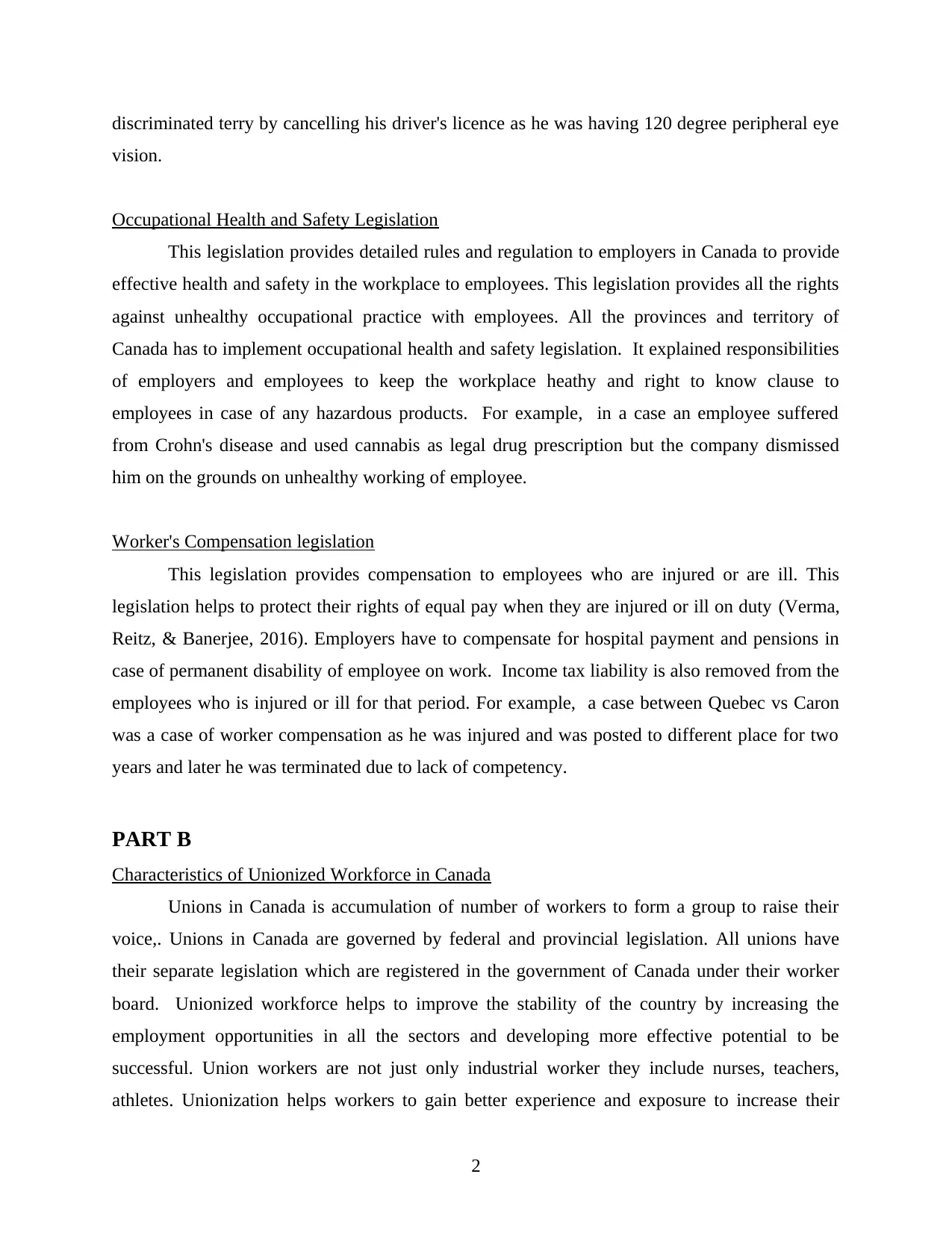
discriminated terry by cancelling his driver's licence as he was having 120 degree peripheral eye
vision.
Occupational Health and Safety Legislation
This legislation provides detailed rules and regulation to employers in Canada to provide
effective health and safety in the workplace to employees. This legislation provides all the rights
against unhealthy occupational practice with employees. All the provinces and territory of
Canada has to implement occupational health and safety legislation. It explained responsibilities
of employers and employees to keep the workplace heathy and right to know clause to
employees in case of any hazardous products. For example, in a case an employee suffered
from Crohn's disease and used cannabis as legal drug prescription but the company dismissed
him on the grounds on unhealthy working of employee.
Worker's Compensation legislation
This legislation provides compensation to employees who are injured or are ill. This
legislation helps to protect their rights of equal pay when they are injured or ill on duty (Verma,
Reitz, & Banerjee, 2016). Employers have to compensate for hospital payment and pensions in
case of permanent disability of employee on work. Income tax liability is also removed from the
employees who is injured or ill for that period. For example, a case between Quebec vs Caron
was a case of worker compensation as he was injured and was posted to different place for two
years and later he was terminated due to lack of competency.
PART B
Characteristics of Unionized Workforce in Canada
Unions in Canada is accumulation of number of workers to form a group to raise their
voice,. Unions in Canada are governed by federal and provincial legislation. All unions have
their separate legislation which are registered in the government of Canada under their worker
board. Unionized workforce helps to improve the stability of the country by increasing the
employment opportunities in all the sectors and developing more effective potential to be
successful. Union workers are not just only industrial worker they include nurses, teachers,
athletes. Unionization helps workers to gain better experience and exposure to increase their
2
vision.
Occupational Health and Safety Legislation
This legislation provides detailed rules and regulation to employers in Canada to provide
effective health and safety in the workplace to employees. This legislation provides all the rights
against unhealthy occupational practice with employees. All the provinces and territory of
Canada has to implement occupational health and safety legislation. It explained responsibilities
of employers and employees to keep the workplace heathy and right to know clause to
employees in case of any hazardous products. For example, in a case an employee suffered
from Crohn's disease and used cannabis as legal drug prescription but the company dismissed
him on the grounds on unhealthy working of employee.
Worker's Compensation legislation
This legislation provides compensation to employees who are injured or are ill. This
legislation helps to protect their rights of equal pay when they are injured or ill on duty (Verma,
Reitz, & Banerjee, 2016). Employers have to compensate for hospital payment and pensions in
case of permanent disability of employee on work. Income tax liability is also removed from the
employees who is injured or ill for that period. For example, a case between Quebec vs Caron
was a case of worker compensation as he was injured and was posted to different place for two
years and later he was terminated due to lack of competency.
PART B
Characteristics of Unionized Workforce in Canada
Unions in Canada is accumulation of number of workers to form a group to raise their
voice,. Unions in Canada are governed by federal and provincial legislation. All unions have
their separate legislation which are registered in the government of Canada under their worker
board. Unionized workforce helps to improve the stability of the country by increasing the
employment opportunities in all the sectors and developing more effective potential to be
successful. Union workers are not just only industrial worker they include nurses, teachers,
athletes. Unionization helps workers to gain better experience and exposure to increase their
2
Paraphrase This Document
Need a fresh take? Get an instant paraphrase of this document with our AI Paraphraser
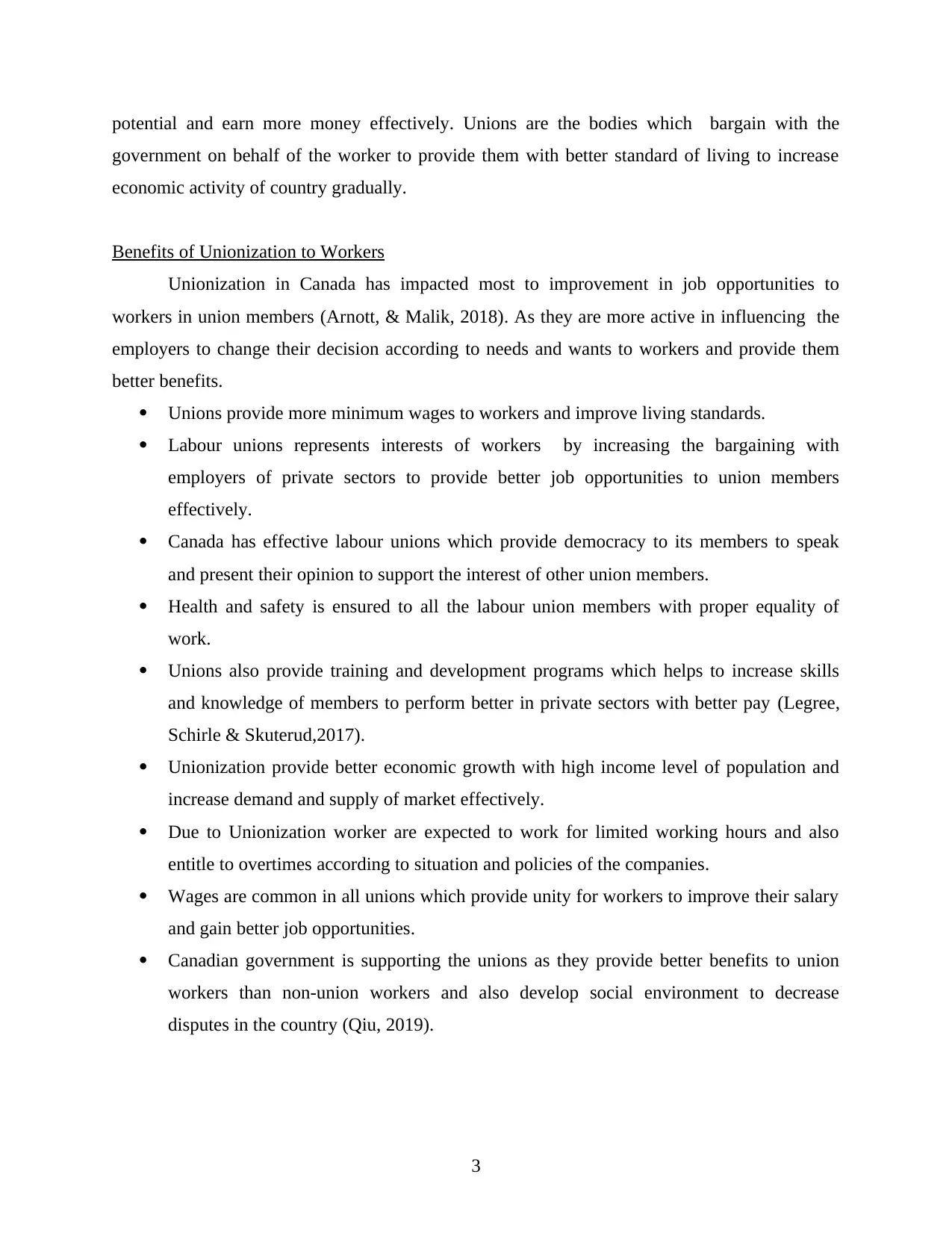
potential and earn more money effectively. Unions are the bodies which bargain with the
government on behalf of the worker to provide them with better standard of living to increase
economic activity of country gradually.
Benefits of Unionization to Workers
Unionization in Canada has impacted most to improvement in job opportunities to
workers in union members (Arnott, & Malik, 2018). As they are more active in influencing the
employers to change their decision according to needs and wants to workers and provide them
better benefits.
Unions provide more minimum wages to workers and improve living standards.
Labour unions represents interests of workers by increasing the bargaining with
employers of private sectors to provide better job opportunities to union members
effectively.
Canada has effective labour unions which provide democracy to its members to speak
and present their opinion to support the interest of other union members.
Health and safety is ensured to all the labour union members with proper equality of
work.
Unions also provide training and development programs which helps to increase skills
and knowledge of members to perform better in private sectors with better pay (Legree,
Schirle & Skuterud,2017).
Unionization provide better economic growth with high income level of population and
increase demand and supply of market effectively.
Due to Unionization worker are expected to work for limited working hours and also
entitle to overtimes according to situation and policies of the companies.
Wages are common in all unions which provide unity for workers to improve their salary
and gain better job opportunities.
Canadian government is supporting the unions as they provide better benefits to union
workers than non-union workers and also develop social environment to decrease
disputes in the country (Qiu, 2019).
3
government on behalf of the worker to provide them with better standard of living to increase
economic activity of country gradually.
Benefits of Unionization to Workers
Unionization in Canada has impacted most to improvement in job opportunities to
workers in union members (Arnott, & Malik, 2018). As they are more active in influencing the
employers to change their decision according to needs and wants to workers and provide them
better benefits.
Unions provide more minimum wages to workers and improve living standards.
Labour unions represents interests of workers by increasing the bargaining with
employers of private sectors to provide better job opportunities to union members
effectively.
Canada has effective labour unions which provide democracy to its members to speak
and present their opinion to support the interest of other union members.
Health and safety is ensured to all the labour union members with proper equality of
work.
Unions also provide training and development programs which helps to increase skills
and knowledge of members to perform better in private sectors with better pay (Legree,
Schirle & Skuterud,2017).
Unionization provide better economic growth with high income level of population and
increase demand and supply of market effectively.
Due to Unionization worker are expected to work for limited working hours and also
entitle to overtimes according to situation and policies of the companies.
Wages are common in all unions which provide unity for workers to improve their salary
and gain better job opportunities.
Canadian government is supporting the unions as they provide better benefits to union
workers than non-union workers and also develop social environment to decrease
disputes in the country (Qiu, 2019).
3

CONCLUSION
This essay concludes that Unionization was very essential in Canada as it helped to
improve the job opportunities and increased communication between all the sectors. This also
helped private sectors to find right talents by integrating with labour unions to increase their
productivity and grow in market effectively.
4
This essay concludes that Unionization was very essential in Canada as it helped to
improve the job opportunities and increased communication between all the sectors. This also
helped private sectors to find right talents by integrating with labour unions to increase their
productivity and grow in market effectively.
4
⊘ This is a preview!⊘
Do you want full access?
Subscribe today to unlock all pages.

Trusted by 1+ million students worldwide
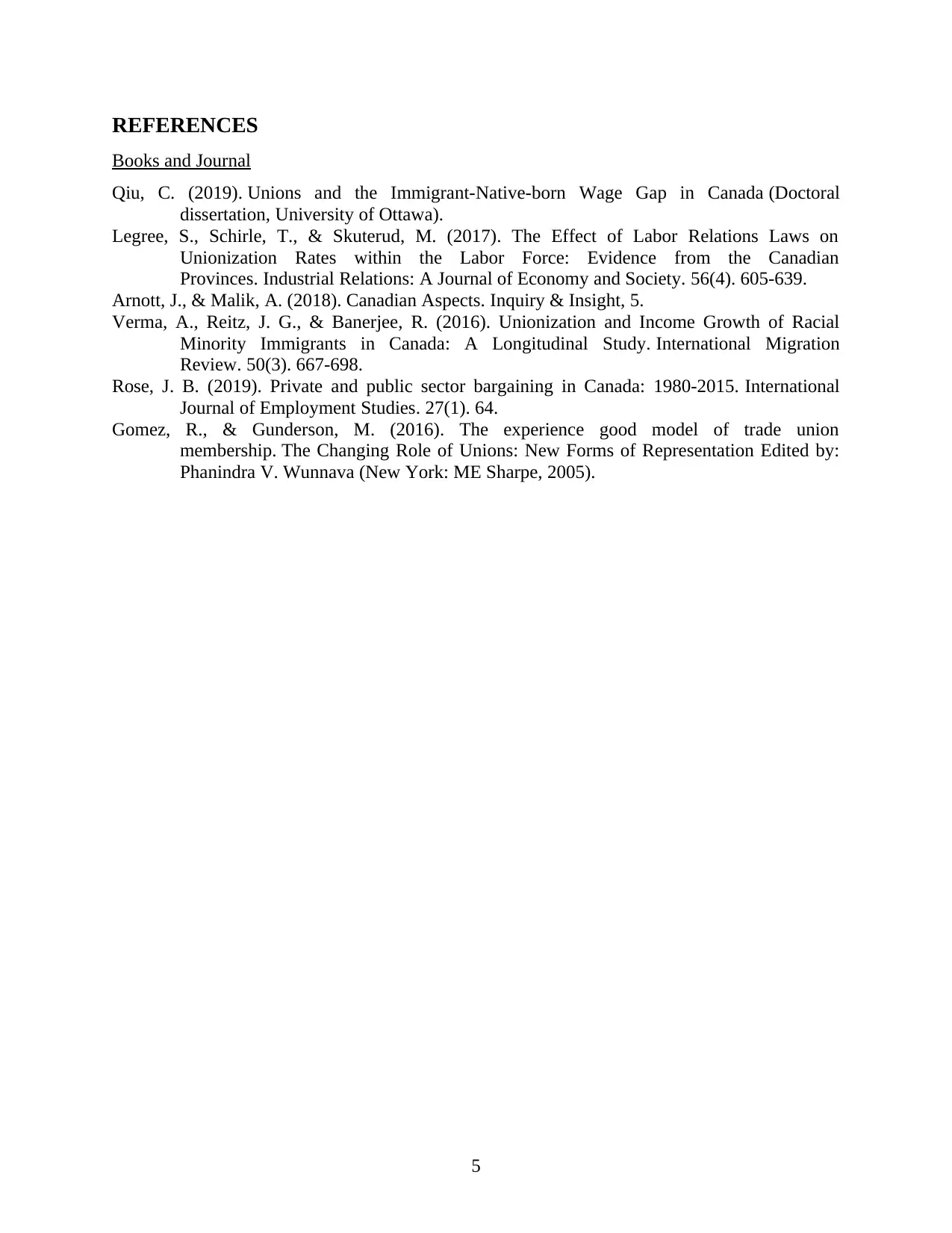
REFERENCES
Books and Journal
Qiu, C. (2019). Unions and the Immigrant-Native-born Wage Gap in Canada (Doctoral
dissertation, University of Ottawa).
Legree, S., Schirle, T., & Skuterud, M. (2017). The Effect of Labor Relations Laws on
Unionization Rates within the Labor Force: Evidence from the Canadian
Provinces. Industrial Relations: A Journal of Economy and Society. 56(4). 605-639.
Arnott, J., & Malik, A. (2018). Canadian Aspects. Inquiry & Insight, 5.
Verma, A., Reitz, J. G., & Banerjee, R. (2016). Unionization and Income Growth of Racial
Minority Immigrants in Canada: A Longitudinal Study. International Migration
Review. 50(3). 667-698.
Rose, J. B. (2019). Private and public sector bargaining in Canada: 1980-2015. International
Journal of Employment Studies. 27(1). 64.
Gomez, R., & Gunderson, M. (2016). The experience good model of trade union
membership. The Changing Role of Unions: New Forms of Representation Edited by:
Phanindra V. Wunnava (New York: ME Sharpe, 2005).
5
Books and Journal
Qiu, C. (2019). Unions and the Immigrant-Native-born Wage Gap in Canada (Doctoral
dissertation, University of Ottawa).
Legree, S., Schirle, T., & Skuterud, M. (2017). The Effect of Labor Relations Laws on
Unionization Rates within the Labor Force: Evidence from the Canadian
Provinces. Industrial Relations: A Journal of Economy and Society. 56(4). 605-639.
Arnott, J., & Malik, A. (2018). Canadian Aspects. Inquiry & Insight, 5.
Verma, A., Reitz, J. G., & Banerjee, R. (2016). Unionization and Income Growth of Racial
Minority Immigrants in Canada: A Longitudinal Study. International Migration
Review. 50(3). 667-698.
Rose, J. B. (2019). Private and public sector bargaining in Canada: 1980-2015. International
Journal of Employment Studies. 27(1). 64.
Gomez, R., & Gunderson, M. (2016). The experience good model of trade union
membership. The Changing Role of Unions: New Forms of Representation Edited by:
Phanindra V. Wunnava (New York: ME Sharpe, 2005).
5
1 out of 7
Related Documents
Your All-in-One AI-Powered Toolkit for Academic Success.
+13062052269
info@desklib.com
Available 24*7 on WhatsApp / Email
![[object Object]](/_next/static/media/star-bottom.7253800d.svg)
Unlock your academic potential
Copyright © 2020–2025 A2Z Services. All Rights Reserved. Developed and managed by ZUCOL.





